 Download this article in magazine layout
Download this article in magazine layout
- Share this article
- Subscribe to our newsletter
Nutrition gardens in Burkina Faso – a green solution for rural food security
Like many countries in West Africa, Burkina Faso is already facing more climate change-related weather extremes, such as very hot days, heavy precipitation events, droughts, and general uncertainties and variabilities of weather. However, the country’s capacity to adapt its agricultural production systems is limited, and its resilience to these additional pressures is low, increasing the urgency for simple, effective and low-cost approaches. One promising adaptation strategy is an innovative production method locally known as Jardin Nutritif (French for “nutritive garden”), which involves the intensive cultivation of moringa and baobab trees. More than 70 per cent of the 20 million Burkinabé are engaged in agriculture to make their livelihoods. Still, the hunger level is serious, and the country ranks 97th out of the 125 countries in the 2023 Global Hunger Index report.
Nutri-gardens are designed to boost the nutritional status, food security and income of impoverished households in rural areas. Since 2000, the World Agroforestry Centre (ICRAF) and agricultural research institutes across various Sahelian countries have undertaken studies showcasing the viability of cultivating baobab trees in gardens. In Burkina Faso, cultivation efforts focus on the production and consumption of nutrient-rich baobab as well as moringa leaves (see Box below). To achieve this, the Burkinabé Institute for Health Sciences Research (IRSS) is collaborating with the Great Green Wall Initiative (GGWI) by promoting the joint production of these plants. Launched in 2007, the GGWI aims to create an 8,000-kilometre (5,000-mile) vegetation band of local tree species from Senegal to Djibouti by 2030, reversing desertification and enhancing food security.
Baobab (Adansonia digitata) and moringa (Moringa oleifera) are highly nutritious and resilient plants valued not only in Burkina Faso, but also in many other African countries. Baobab is famous for its fruits and seeds, and its leaves, rich in essential minerals and protein, are crucial for the diets of vulnerable groups. Moringa, originating from India, thrives in harsh climates and is versatile: its leaves are rich in protein and vitamins, its seeds purify water, and its various parts have medicinal uses. Both plants, classified as neglected and underutilised species (NUS), require minimal resources, resist pests and adapt well to extreme climates, making them sustainable and nutritious food sources.
How nutri-gardens are set up and managed
The set-up process of nutri-gardens is typically overseen by a technical officer from the local forestry department and follows a similar pattern. First, negotiations on user rights, potential compensation and specific terms with the landowner are conducted and agreed upon. Contractual partners are usually international NGOs, bilateral cooperation schemes that are often initiated by the GGWI or mining companies such as the Russian company “Nordgold”. These companies are legally obliged to carry out development measures in the affected communities. The regional forestry authority determines the project(s) to be carried out in consultation with the community and the company. As soon as an agreement is reached and the funds are made available, the local forestry service implements the project.
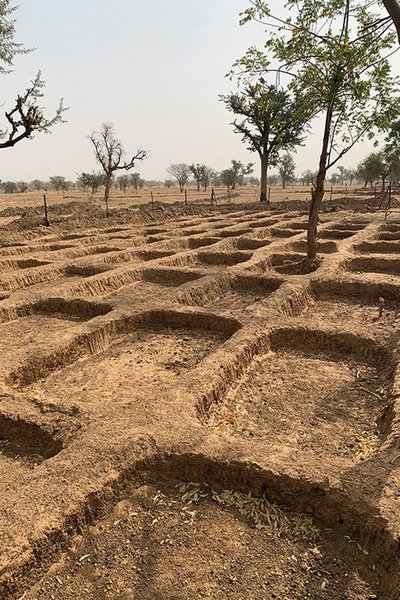
Planting plots.
Photo: Silke Stöber
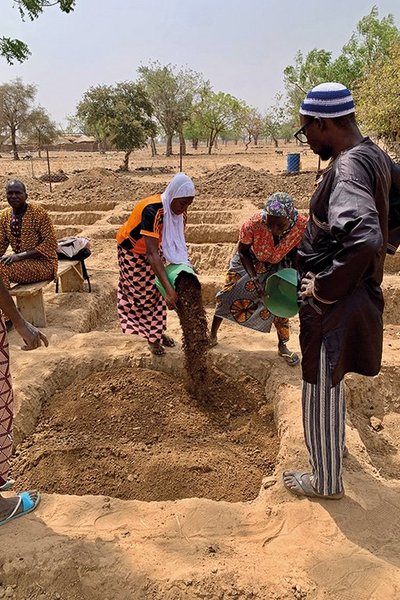
Filling beds with compost.
Photo: Silke Stöber
Once all negotiations are finalised, the designated area is fenced off, and individual planting plots are delineated using wooden boards measuring precisely three metres in length and one and a half metres in width, with a 30-centimetre gap maintained between the beds to optimise spatial utilisation. The top 30 centimetres of soil are then excavated, and a soil-animal manure blend is formed with the extracted soil to ensure optimal fertility, tailored to the soil’s inherent structure and texture. To facilitate uprooting after a certain time, a thin layer of sand is added to the baobab beds. It is positioned 15 centimetres below the intended surface level to aid root establishment. Seeds are then uniformly dispersed within the beds with a consistent spacing of 20 centimetres between the seeds. Each bed is dedicated to a single species only. Before sowing, baobab seeds undergo acid scarification by immersing them in a sulphuric acid solution for half an hour, followed by water for one hour, while moringa seeds are simply soaked in water for 24 hours. Once prepared, the seeds are introduced into the beds, fully covered with the soil-fertiliser mix and regularly watered. Moringa seedlings typically germinate within about a week, while baobab seedlings emerge after approximately two weeks. In Burkina Faso, innovative methods combine trees with other plants, cultivated in beds. Recent advancements include solar-powered boreholes and the intercropping of onions and tomatoes. In Niger, these nutri-gardens often also incorporate vegetables.

Young trees with leaves sprouting.
Photo: Robert Doulkom
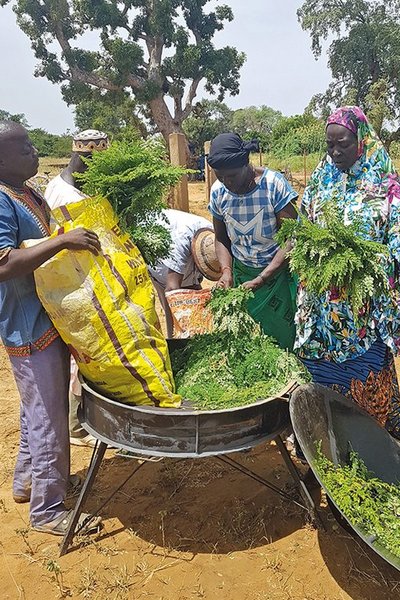
The dryer being filled with leaves.
Photo: Judith Henze
Although nutri-gardens can be established year-round, in Burkina Faso, implementation often occurs during the rainy season to ensure water availability. Irrigation is normally performed with a watering can, although in rare cases, pipes are used. Incidences of pest and diseases are minimal for both species, making them suitable candidates for cultivation in such a dense production system.
Once established, the gardens are primarily managed by women’s groups, often organised into cooperatives. These cooperatives align with the government’s goal to promote village organisations in Burkina Faso. Individual beds are allocated to participants, with members taking responsibility for their designated area, including tasks such as setup, cultivation and regular maintenance such as watering, hoeing, weeding and pruning. In cases where members are unable to fulfil their obligations because of illness or other reasons, assistance is provided by fellow members. Harvesting and income distribution are managed collectively.
With proper maintenance and adequate water supply, the first harvest can occur approximately 45 days after sowing. A portion of the yield is consumed by the community members or shared as gifts with visitors, neighbours, or relatives. Another part is sold as fresh produce in the local market, while the rest undergoes drying, grinding and packaging. To preserve their nutrients, the leaves are dried either in the shade or in a designated dryer. Dried and ground moringa leaves offer versatility as a food fortifier, and are traditionally used to enrich porridge, bread, biscuits, tea, smoothies and juices with their nutritious powder.
The gender aspect
The Burkinabé government supports the formation of women’s cooperatives through affirmative action policies permitted by law. In 2010, there were 2,500 cooperatives in the country, with one-third being women’s cooperatives. These are generally smaller in scale compared to men’s. Overall, about one in three participants in Burkina Faso’s cooperatives is female. These cooperatives typically work on land provided by men from their villages. Land in Burkina Faso always belongs either to an individual man or to a family. Yet sometimes the following challenge arises: when women’s cooperatives engage in agricultural activities that enrich the soil, the land’s value increases. Consequently, the landowner may want to reclaim the land after a few years, causing the women to lose their production base. However, social pressure on the landowners through the women’s spouses was reported as an effective method to prevent them from reclaiming the land.
This cycle continues year-round, with harvesting every two weeks for up to two years in this intensive system. After a period of two to five years, when the yield of the leaves and the profit are decreasing, the plants are either transplanted to neighbouring open fields as part of the GGWI or they are sold, with the profits contributing to the renewal of the garden and the replanting of the planting beds. Cultivating baobab and moringa using this system combats both hunger and advancing desertification when the older trees are planted in the arid Sahel, where they help green the region. This method has proven effective on a small scale and could serve as a model for broader cultivation of the tree.
Looking at benefits and challenges
In November 2023, as part of the NutriGreen Project (see Box at the and of article), five focus group discussions were conducted with women’s groups in four villages of Oubritenga Province, Plateau Central, and one village of Sannementenga Province, Centre North region, Burkina Faso, to evaluate the benefits and challenges of nutri-gardens. After gathering data, each woman ranked each factor on a scale of 1 to 5 according to its perceived importance. Here, the following four key benefits were identified:
Economically, nutri-gardens, particularly the baobab component, serve as a crucial financial resource for women. The revenues generated provide vital funds for various needs such as clothing, telephone credit and household expenses, enhancing financial resilience.
In terms of food security, the cultivation of moringa and baobab leaves enriches the diet of the members and their families, promoting food diversity. The sale of these leaves enables households to procure additional food items, strengthening food security within the community.
From a health perspective, the direct consumption of moringa leaves offers essential nutrients, vitamins and minerals, leading to improved health outcomes. The income from leaf sales also supports access to healthcare services, enhancing healthcare utilisation in the community.
Socially, nutri-gardens provide a meaningful occupation, especially during the dry season, acting as a source of employment and engagement. This not only enhances individual well-being but also fosters social cohesion, promoting solidarity and a sense of collective purpose among community members.
The following proved to be challenges:
Water availability. In some gardens, the distance between garden plots and water sources poses a logistical challenge. Women must transport heavy water containers after labour-intensive pumping. Wells may also deteriorate or have seasonal water level fluctuations, particularly towards the end of the dry season between April and June. Furthermore, the broader village context adds complexity, with competition for limited water resources among various user groups.
Market reliability. Most nutritive gardens struggle with a lack of consistent, well-paying customers. Women’s groups often rely on word-of-mouth advertising, which may not effectively reach potential buyers.
Equipment deficiencies. Inadequate production and processing equipment, such as insufficient dryers and storage facilities, hinder on-site processing. Solar dryers can face challenges during periods of insufficient solar radiation, leading to production losses.
How to improve this innovative system of nutri-gardens?
Many NGOs as well as government projects have adopted this innovative production system in their local projects, including the French-initiated Solidarité Herbignac Burkina (SOL-HER-BU), the Swiss-funded Tiipalga and the Canadian NGO Ceci Burkina Faso. In particular, the UK NGO Tree Aid has set up over 200 nutrition gardens across West Africa since 2017. Based on the challenges recorded, future nutrition gardens must adjust their setup and maintenance process. Involved NGOs and forestry and agriculture government offices should provide ongoing and structural assistance beyond the initial setup phase to ensure the sustainability of nutri-gardens. This includes maintaining water availability and offering support with drying, processing, packaging and establishing reliable outlet markets. These measures are crucial for their long-term economic viability.
It is further important to address the lack of regular, reliable and well-paying buyers for moringa or baobab leaves. Profitability is the key incentive for women farmers to sustain their nutrition gardens, especially as they often bear caregiving responsibilities alongside farm management. NGOs and government projects should therefore assist in identifying and engaging with reliable customer bases, such as local educational institutions, street vendors, restaurants and supermarkets. Nutri-garden cooperatives must explore opportunities for value addition at the production site to enhance financial stability and optimise revenue streams. Integrating fresh moringa leaves into products like juices or jams is the best way to expand the product range while capitalising on the nutritional benefits of moringa. This approach not only diversifies income sources but also increases the appeal of nutri-gardens’ products to a broader market.
By focusing on these recommendations, the Burkinabé government and implementing NGOs can and will contribute to the long-term success and sustainability of nutri-gardens, ensuring their positive impact on communities’ economic, nutritional and social well-being.
NutriGreen – Strengthening the resilience of local food systems
The NutriGreen project addresses the urgent challenges faced by Senegal and Burkina Faso due to the increasing extreme weather events associated with climate change, which exacerbate food insecurity. It focuses on indigenous vegetable and tree crops, with the clear goal of strengthening the resilience of local food systems. The project is to achieve this through sustainable value chains, innovative technologies and community involvement. In Zitenga, on the Plateau Central, Burkina Faso, and in the Thiès region, Senegal, NutriGreen identifies and tests innovative production, post-harvest, processing and marketing technologies tailored to the needs of local communities.
NutriGreen is a multi-stakeholder initiative that involves local players in the food system. The project employs a transformative action learning and co-creation of knowledge approach, with students testing sustainable intensification and diversification methods with groups of women farmers in climate field schools. The immediate challenges of food security are addressed by utilising indigenous knowledge, sustainable practices and community collaboration. The project is financially supported by the German Federal Ministry of Food and Agriculture (BMEL), through the Federal Office for Agriculture and Food (BLE). It receives funding from the European Union’s Horizon 2020 research and innovation programme.
Judith Henze is a freelance consultant on food security and biodiversity and was the coordinator of the NUTRiGREEN project from 2021 to 2024.
Robert Doulkom is a forester employed at the forestry department in Ziniaré, Plateau Central, Burkina Faso.
Silke Stöber is Head of Research at the Centre for Rural Development (SLE) at Humboldt-Universität zu Berlin, Germany.
Contact: silke.stoeber@agrar.hu-berlin.de


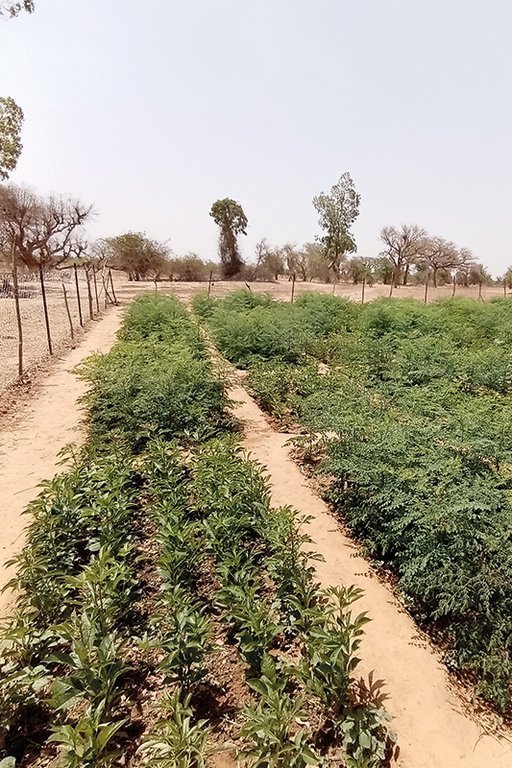
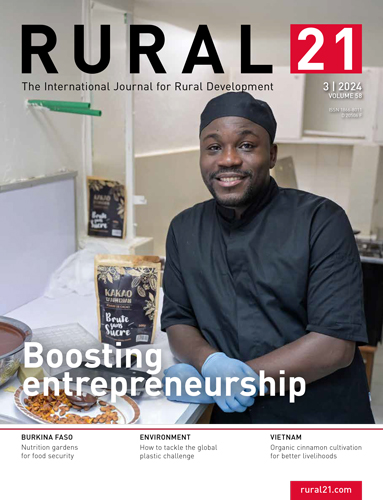
Add a comment
Be the First to Comment